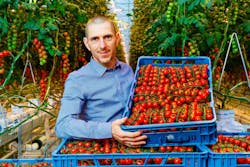Less heat from LED grow lights? That’s good, say two tomato growers
In the ongoing question of whether low heat emissions from LED horticultural lighting might negatively affect the growth of crops accustomed to warmth from conventional high-pressure sodium (HPS) lights, a couple of Benelux tomato growers have provided a new spin: Too much HPS heat can be detrimental, so it makes sense to use a mix of HPS and LED.
That’s what Holland’s Bryte and Belgium’s Den Berk Délice did starting late last year, mixing Signify Philips GreenPower LED toplights with HPS.
“The big advantage of LED lighting is that there is much less radiant heat from the light, which gives us more control over the climate in the greenhouse,” said Bryte co-owner Erik Zwinkels, whose operation has 40 hectares in total — 24 of which tap indoor lighting — and used the hybrid lighting at 8 hectares.
The notion that less heat in a greenhouse can be good runs counter to the concerns that another tomato grower expressed not long ago, when Belgium’s Tomato Masters worried there would not be enough heat in a greenhouse lit entirely by LEDs. Tomato Masters took extra measures to assure there would be optimal conditions.
In a sense, Holland’s Bryte did the same thing with its hybrid HPS/LED approach. Concerned about too much heat, it ironically added another heat source that it could control better than the heat emitted by inefficient HPS lighting.
“In our case, the best solution was to introduce extra heat from the bottom of the greenhouse,” said Mark Zwinkels, Erik’s brother and also co-owner of Gravenzande-based Bryte. “We also noticed that control errors were less likely to be made due to better control over the climate, and that the climate became more constant. We saw positive crop development and were satisfied with the fruit weight and the crop growth.”
The issue, then, is controllable heat.
“We noticed that we are much more in control with LED,” said Lucas Aertsen, cultivation manager at Den Berk Délice, which like Bryte deployed the hybrid LED/HPS approach. Rijkevorsel-based Den Berk maintains temperatures of up to 28°C in winter. It deployed the hybrid lights at 10 hectares out of a total of 60.
Both Bryte and Den Berk Délice are delivering 180 µmol/s/m2 light, distributed across 90 µmol/s/m2 LED and 90 µmol/s/m2 HPS light, according to Signify.
In a yet again different take on the LED versus HPS heat issue in horticultural lighting, Dutch rose grower Marjoland recently deployed a hybrid LED/HPS scheme in which it counted on heat from the HPS and on the spectral tuning, light levels, and energy efficiency of the LED lights provided by Signify.
As LEDs increasingly work their way into greenhouses, growers will continue to tailor their own answers to the heat question. Concerns like these will be addressed in case-study discussions about environmental controls in grower operations during LEDs Magazine’s HortiCann Light + Tech virtual event in October.
LED horticultural lighting, with its potential to improve the world’s food supply, is one of the categories that Signify CEO Eric Rondolat singled out this week as key in addressing environmental and human sustainability. The broad focus on sustainability rings not just an ethical tone, but also a business one as the lighting industry ratchets up its search for new areas while facing an uncertain future in the pandemic-shaken commercial office market, traditionally a mainstay revenue source.
MARK HALPER is a contributing editor for LEDs Magazine, and an energy, technology, and business journalist ([email protected]).
For up-to-the-minute LED and SSL updates, why not follow us on Twitter? You’ll find curated content and commentary, as well as information on industry events, webcasts, and surveys on our LinkedIn Company Page and our Facebook page.

Mark Halper | Contributing Editor, LEDs Magazine, and Business/Energy/Technology Journalist
Mark Halper is a freelance business, technology, and science journalist who covers everything from media moguls to subatomic particles. Halper has written from locations around the world for TIME Magazine, Fortune, Forbes, the New York Times, the Financial Times, the Guardian, CBS, Wired, and many others. A US citizen living in Britain, he cut his journalism teeth cutting and pasting copy for an English-language daily newspaper in Mexico City. Halper has a BA in history from Cornell University.





